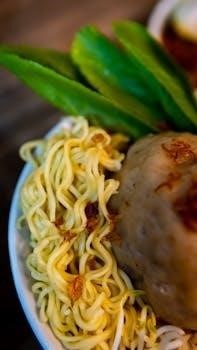
Finding Your Zojirushi Rice Cooker Instruction Manual
Zojirushi offers comprehensive instructions on their website․ Their Instruction Manual page allows you to choose your product category to easily find and master the art of using your top-quality Zojirushi products․ It’s a great resource if you’ve lost your physical manual․
To find the correct manual, have your Zojirushi rice cooker model number ready․ A manual for a similar model may also be helpful if you can’t find your exact one․ The Zojirushi website provides manuals for its appliances, including the latest models․
Online Zojirushi Manuals
Accessing your Zojirushi rice cooker’s instruction manual online is a convenient alternative if you’ve misplaced the physical copy․ Zojirushi provides a dedicated “Instruction Manuals” page on their official website, ensuring users can readily find the specific guide for their model․ This digital resource offers comprehensive instructions, covering everything from initial setup to advanced cooking techniques․
The online manuals typically include detailed diagrams, troubleshooting tips, and safety precautions, enhancing your understanding of the appliance’s operation․ To locate your manual, navigate to the Zojirushi website and look for the “Service & Support” or “Manuals” section․ You’ll usually be prompted to enter your rice cooker’s model number, which is generally found on a sticker located on the bottom or back of the unit․ Once you input the correct model number, you can view and download the PDF manual․
Many third-party websites also host Zojirushi manuals; however, it’s always best to obtain the manual directly from the official Zojirushi website to ensure accuracy and completeness․
Model Number is Important
Identifying your Zojirushi rice cooker’s model number is crucial when searching for the correct instruction manual․ Zojirushi manufactures a wide range of rice cookers, each with unique features and functionalities․ The model number acts as a specific identifier, ensuring you access the exact manual tailored to your appliance․
Typically, the model number is printed on a label affixed to the rice cooker’s exterior․ Look for it on the bottom, back, or side of the unit․ The label may also include other identifying information, such as the serial number and manufacturing date․ Once you’ve located the model number, write it down for easy reference․ When searching online for the manual, be precise and enter the complete model number, including any letters or numbers that follow the main sequence․
Using the correct model number will lead you to the appropriate manual, guaranteeing that you receive accurate instructions and safety guidelines specific to your Zojirushi rice cooker․ This will allow you to optimize the appliance’s performance and longevity․

Essential Operation Instructions
Accurate rice measurement is key․ Use the provided measuring cup, leveling the rice at the top․ Other cups may vary․ Consistent measurement ensures perfect cooking, following the manual’s precise instructions․ The rice-to-water ratio is also important․
Measuring Rice Accurately
When using a Zojirushi rice cooker, precise rice measurement is critical for optimal results․ Always utilize the measuring cup that comes specifically with your Zojirushi model, as other measuring cups may provide inaccurate volumes․ This ensures the correct rice-to-water ratio, a crucial factor in achieving perfectly cooked rice every time․
Level the rice off at the top of the cup to maintain accuracy in your measurements․ Avoid packing the rice into the cup, as this will result in using too much rice and potentially affecting the final texture and consistency of your cooked rice․ Consistency is key to achieving consistent results․
Different types of rice may require slightly different water ratios․ The instruction manual for your specific Zojirushi model will provide detailed guidelines for various rice types, including white rice, brown rice, and other specialty grains․ Refer to the manual for precise water level recommendations․
By adhering to these guidelines for accurate rice measurement, you can ensure that your Zojirushi rice cooker consistently delivers perfectly cooked rice, enhancing your culinary experience with every meal․
Water Ratio Guidelines
Achieving the perfect rice texture with your Zojirushi rice cooker hinges on using the correct water ratio․ Consult your Zojirushi’s instruction manual for specific water level guidelines tailored to different rice types․ These guidelines are crucial, as each type of rice absorbs water differently, impacting the final texture and taste․
Generally, white rice requires a 1⁚1 water-to-rice ratio, but this can vary slightly depending on the rice variety and your personal preference․ Brown rice typically requires more water than white rice due to its bran layer․ Experimentation might be needed to find your ideal water level․ Some users use a 3⁚2 ratio of water to rice for Basmati rice․
The inner cooking pan of your Zojirushi rice cooker usually has water level lines marked for different rice types․ Use these lines as a guide, but remember that these are just starting points․ Adjust the water level slightly based on your experience and the specific rice you are using․
For softer rice, add a little more water․ For firmer rice, use a little less․ Keep in mind external factors like altitude and humidity can also affect the cooking process and may necessitate slight adjustments to the water ratio․
Cooking Different Types of Rice
Your Zojirushi rice cooker is designed to cook a variety of rice types, each requiring slightly different settings and water ratios․ The instruction manual is your best guide for understanding the specific requirements of each type․ White rice, brown rice, sushi rice, and even semi-brown rice can be cooked to perfection with the right settings․
For white rice, use the “White Rice” setting․ Ensure the correct water level according to the markings on the inner cooking pan․ Brown rice requires a longer cooking time and more water․ Use the “Brown Rice” setting on your Zojirushi and adjust the water level accordingly․ Some models even have a “Semi-Brown Rice” setting․
Sushi rice needs a slightly different approach․ After cooking, it’s traditionally mixed with vinegar to achieve its signature flavor and texture․ Refer to your manual for the best cooking settings and consider using a slightly lower water level for a firmer texture․
Experiment with different rice types and settings to discover your preferences․ Your Zojirushi rice cooker offers versatility beyond just white rice, allowing you to explore a world of flavors and textures․

Care and Maintenance
Clean the inner cooking pan, lid, and accessories with warm, soapy water after each use․ Wipe the exterior with a damp cloth․ Always unplug the rice cooker before cleaning․ Proper cleaning ensures longevity and optimal performance․
Cleaning the Inner Cooking Pan and Lid
After each use, it is crucial to thoroughly clean the inner cooking pan, the inner lid, and any included accessories to maintain the performance and hygiene of your Zojirushi rice cooker․ Begin by removing the inner cooking pan from the main unit, followed by detaching the inner lid, usually a simple process involving a release mechanism․ Wash these components with warm, soapy water using a non-abrasive sponge or cloth to avoid scratching the surfaces․
Pay close attention to removing any residual rice or food particles that may have stuck to the pan or lid․ For stubborn stains, a gentle soaking in warm, soapy water before washing can be beneficial․ Rinse all parts thoroughly with clean water to remove any soap residue․
Ensure that all components are completely dry before reassembling them back into the rice cooker․ This will prevent the growth of mold or bacteria and maintain the overall cleanliness of the appliance․ Regular cleaning of these parts is essential for ensuring the longevity of your Zojirushi rice cooker and preserving the quality of your cooked rice․
Exterior Cleaning
Maintaining the exterior of your Zojirushi rice cooker is as important as cleaning the interior components to ensure its longevity and aesthetic appeal․ Before commencing any cleaning procedure, it is imperative to unplug the rice cooker from the power outlet to prevent any electrical hazards․
To clean the exterior, use a soft, damp cloth to wipe down the surfaces․ Avoid using abrasive cleaners, scouring pads, or harsh chemicals, as these can damage the finish of the rice cooker․ For stubborn stains or spills, you can use a mild detergent diluted in water, but ensure that you wipe off any soap residue with a clean, damp cloth afterward․
Pay attention to areas such as the control panel and the edges of the lid, where dust and grime can accumulate․ Ensure that no water enters the interior of the rice cooker during cleaning, as this can damage the electronic components․ After wiping down the exterior, use a dry cloth to buff the surfaces and remove any remaining moisture․ Regular cleaning of the exterior will keep your Zojirushi rice cooker looking its best and prevent the buildup of dirt and debris․

Troubleshooting and Safety
Avoid overfilling the rice cooker․ This can lead to spillage and affect cooking performance․ Always adhere to the water level guidelines provided in the instruction manual to ensure optimal cooking results and prevent any potential hazards․
Avoiding Overfilling
Overfilling a Zojirushi rice cooker poses several risks․ Firstly, excess water can cause the rice to cook improperly, resulting in a mushy or uneven texture․ Secondly, overfilling can lead to water and starch overflowing during the cooking process, creating a mess on the countertop and potentially damaging the appliance’s heating element․
To avoid overfilling, carefully measure both the rice and water according to the manufacturer’s instructions․ Use the measuring cup provided with the rice cooker, as other measuring cups may differ in size․ Level the rice at the top of the cup to ensure accuracy․
Pay close attention to the water level markings inside the inner cooking pan․ These markings indicate the correct water level for different types of rice and quantities․ When cooking a smaller amount of rice, reduce both the rice and water proportionally․
Additionally, consider the type of rice you are cooking․ Some types of rice, such as brown rice, may require more water than white rice․ Consult the instruction manual for specific water ratio recommendations for different rice varieties․ Proper measurement and adherence to guidelines are essential for optimal results․
If overfilling occurs, immediately unplug the rice cooker and allow it to cool completely before cleaning․
Keep Warm Function Limitations
The Keep Warm function on a Zojirushi rice cooker is designed to maintain the rice at a serving temperature after cooking․ However, it’s essential to understand the limitations of this feature to prevent the rice from drying out or developing an undesirable texture․ Leaving rice in the Keep Warm mode for extended periods can affect its quality․
The user manual often advises against keeping cooked rice in the cooker on the Keep Warm setting for more than five hours․ Exceeding this time frame may cause the rice to become hard, dry, and less palatable․ The duration can vary slightly depending on the specific model․ The quality of rice will diminish over time․
To maximize the effectiveness of the Keep Warm function, stir the rice occasionally to distribute moisture evenly․ If you plan to keep the rice warm for a longer duration, consider adding a small amount of water to the rice and stirring it in before activating the Keep Warm setting․ However, be mindful of adding too much water․
For optimal rice quality, it’s best to consume the rice shortly after cooking․ If you have leftover rice, store it properly in an airtight container in the refrigerator to preserve its freshness and texture․ Avoid prolonged use of the Keep Warm function to maintain the best possible rice quality․
Repair Inquiries and Safety Precautions
When dealing with any appliance repair, especially with electrical devices like a Zojirushi rice cooker, safety should always be the top priority․ Under no circumstances should you attempt to disassemble or repair the unit yourself unless you are a qualified and trained repair technician․ Attempting to do so can result in dangerous situations․
Improper repairs can cause fire, electrical shock, or serious injury․ If your Zojirushi rice cooker requires repair, direct any repair inquiries to authorized service centers․ Contact Zojirushi’s customer support or consult your user manual for a list of authorized repair facilities․ Using an authorized service center ensures the repair is conducted safely․
Before contacting for repair, ensure the appliance is unplugged from the power outlet to prevent electrical hazards․ When describing the issue, provide detailed information about the problem․ Include the model number of your rice cooker and a clear explanation of the malfunction․ Always follow safety precautions․
Adhering to safety precautions will protect you from potential harm․ If you are unsure about any aspect of the appliance’s operation, refer to the user manual or contact customer support for guidance․ Prioritize your safety and the integrity of the appliance․
